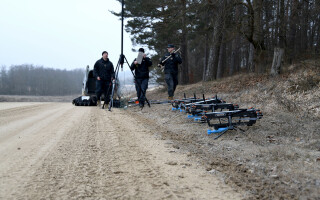The UFO Report, robotic sharks and lobsters, and the Kill Web - Blog
August 30, 2021WARFARE EVOLUTION BLOG. On 25 June 2021, the Director of National Intelligence (DDNI) released the much-anticipated UFO report. It’s only NINE pages long, and includes the status of 144 UAPs (Unidentified Aerial Phenomena, the new and improved name for UFOs) collected by the AATIP (Advanced Aerospace Threat Identification Program) from 2004 through the first half of 2021. One of those UAPs was identified as a deflating weather balloon, and the remainder were designated as unknown. There is also a classified version of this report (17 pages long) submitted to congressional Intelligence and Armed Services Committees. I suspect those additional eight pages just contain secret sources and collection methods rather than additional facts. You can read the unclassified report on the web.
Kill Web technology update - Blog
June 30, 2021WARFARE EVOLUTION BLOG: There’s been a number of advancements in technology going into the Kill Web lately but none of them, individually, would warrant a focused article unless I overhyped their potential, wildly speculated about their capabilities, or just made-up some stuff. That approach could seriously jeopardize my standing as an amateur blogger and irritate my publisher. So, let’s avoid that possibility and briefly cover a few of the developments here.
Disaggregation and the Kill Web - Blog
May 26, 2021WARFARE EVOLUTION BLOG. In my previous articles, I may have left the impression that with the technology we have today, hooking all ISR (intelligence, surveillance, and reconnaissance) and weapons systems together into a seamless, multi-service, multi-domain battle network should be straightforward. Technologically, it is achievable. But operationally, there are serious complex trade-offs that make the decisions difficult. Let’s look at a few of them here, so you have a better idea why building the Kill Web will take some time, lots of testing, and continuous updates to make it function properly.
"Kill TV," decision science, AI, and the Kill Web - Blog
February 25, 2021WARFARE EVOLUTION BLOG. During the night of 7 October 2001, [Central Intelligence Agency] CIA-controlled Predator drone 3034 was flying over a mud-walled compound in Afghanistan, the suspected hideout of Taliban leader Mullah Omar. The infrared (IR) sensors picked-up heat signatures from three vehicles and a motorcycle leaving and heading toward Kandahar. The drone pilot, and the weapons officer controlling the two on-board Hellfire missiles, were sitting in a trailer on the grounds of CIA-headquarters (HQ) in Langley, Virginia. The video images from the Predator were being streamed, via satellite links, to the big flat-screen TVs at Langley, to the offices of military brass at the Pentagon, General Franks' office at central command (CENTCOM) in Tampa, Florida, to the offices of General Deptula in Qatar (who was controlling Air Force fighter planes and bombers over Afghanistan), and the office of General Jumper, the Chief of Staff of the Air Force. Ordinary soldiers call this video network "Kill TV," for reasons that will become obvious.
Cloud computing, supercomputers, black boxes, and the Kill Web - Blog
November 30, 2020WARFARE EVOLUTION BLOG. Back in 1991, U.S. and coalition forces decimated the Iraqi Army in 42 days during Operation Desert Storm. At the time, Iraq had the world’s fifth largest army. Can we do better than 42 days in the future? Yes, with the help of cloud computing and a supercomputer.
Origins of the Kill Web - Blog
September 29, 2020WARFARE EVOLUTION BLOG: DARPA (Defense Advanced Research Projects Agency) officials announced the concept of the Kill Web at the C4ISRNET Conference in May 2018. Throughout the history of war, many elements of the Kill Web were being developed independently, but the dots were not connected until Admiral William Owens wrote a paper about a “system of systems”. He proposed integrating command-and-control, the intelligence from the sensors, and the weapons together in the mid 1990s. He also coined the acronym ISR (for intelligence, surveillance, and reconnaissance).
UFOs and the kill web - Blog
July 29, 2020WARFARE EVOLUTION BLOG. In late 2013, Combat Aircraft Monthly magazine published an article about the Iranian military’s encounters with UFOs (Unidentified Flying Objects). The article states that in November 2004 and again in January 2012, the Iranian Air Force scrambled their fighter planes to intercept unidentified aircraft flying over their secret nuclear facilities. The pilots reported that the invading aircraft were spherical, emitted a greenish light, executed maneuvers that defied the laws of physics, disabled the electronic systems onboard their fighter planes, and flew away at MACH 10 (7672 MPH). Iranian authorities insisted that these unidentified aircraft were advanced-technology reconnaissance drones flown by America’s CIA. This incident, among many others, demands that we explore UFOs and how they fit in the kill web.
Unmanned fighter planes (UCAVs) and the kill web - Blog
June 09, 2020WARFARE EVOLUTION BLOG. Unmanned autonomous fighter planes are the most interesting elements in the advanced kill web, even more intriguing than the manned super-stealthy 6G fighter planes we discussed in previous articles. UCAVs (Unmanned Combat Aerial Vehicles) have the potential to render our enemy’s A2/AD (anti-access/area-denial) strategies completely obsolete. These platforms appear under different names: Loyal Wingman, ATC (Airpower Teaming System), Dark Sword, Taranis, Remote Carriers, nEUROn, and Sidekicks. To understand how they enhance the kill web, we need to look at their specifications and their missions.













